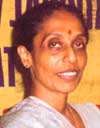| |
A NEW BEGINNING |
|
| Revelling in rain New rain centre in Chennai |
||
CAMPAIGN |
||
| The rights denied Guardians of lakes Rescuing isolated wetlands |
||
IN FOCUS |
||
| Return of the khatris Chandela bunds in bind |
||
INITIATIVE |
||
| Creating
water warriors: CSE trains plumbers and masons Meet us every Friday! Reaping the benefits New dawn Roofwater tappers Every drop counts Harvesting Hope: Sixth Paani Yatra Pride of Doon Tackling water scarcity Turning point |
||
CSE'S LATEST DESIGNS |
||
| Model
projects: Showing the way Eco-conscious business sense |
||
TECHNOLOGY |
||
| Recipe for
greenery Hi-tech filter Better management Can we create rain? |
||
JAL BIRADARI |
||
| Jal
sunwai in Indore |
||
JAL YODHAS |
||
| Shanta
Sheela Nair Vijay Kumar |
||
NEWS FROM CHENNAI |
||
| Temple tank
revived Looking beyond A study planned |
||
NEWS FROM GUJARAT |
||
| Rebuilding
Bhuj |
||
FUNDING AGENCY |
||
| Japan's
loan for rural development |
||
NEWS FROM ABROAD |
||
| Nepal:
Have milk instead.... Bangladesh: Antidote to arsenic |
||

Vol. 4
No.
3
June 2002
![]()
Jal Sunwai in Indore
The Madhya Pradesh (MP) jal biradari (water community) organised a state-level public meet in Kasturbagram, Indore, on May 25. The aim of this meeting was to discuss the long-term impact of the national water policy (NWP) on India and on MP, in particular.
The guest speakers included K J Vyas, former advisor to the Rajiv Gandhi Watershed Mission; Ramaswamy Aiyar, former chief secretary in the Water Resources Department at the Centre; Rajendra Singh, secretary of Tarun Bharat Sangh, an Alwar-based NGO; and, Medha Patekar from the Narmada Bachao Andolan.
The day began with Suresh Mishra from Eklavya, a Bhopal-based NGO, briefing the participants about the reach and functioning of the MP jal biradari. In the first session the NWP was discussed. Aiyar, who drafted the first NWP, lamented that "No attempt has been made to discuss issues like privatisation on a public forum. If the views of people at large were taken into consideration, the contents of the policy would have been completely different."
Shravan Garg, editor of Danik Bhaskar, on the other hand, expressed his disappointment with the inadequate role played by the media in flagging the faults in NWP. The session concluded with the release of ‘Boondhon Ki Sunwai’, a joint compilation by Danik Bhaskar and the MP jal biradari.
The second session concentrated on looking for solutions to the water crisis. While speaking on the relevance of region-specific solutions, Kanti Chaturvedi from Indore felt "water works done in Badnwar, Bhanpur, Patelawad and Swadhyay mandals are exemplary and should be replicated." Paramthesh Ambhasathan from the Samaj Pragati Sahyog informed the participants about watershed projects undertaken by about 90 villages in the Bagali region.
The concluding session discussed the contents of MP’s water policy. Later, a samiti was formed for the preparation of an alternate state-level water policy and Eklavya was given the responsibility to compile the work being done under MP jal biradari.Singh wrapped up the meet by informing the participants about the water walk, that will begin from here and would conclude at Delhi, in August.
For further information:Suresh Mishra, Eklavya Foundation
E – 1/138, Arera Colony, Bhopal
![]()
Shanta Sheela Nair
 You might as well call her Chennai’s water
woman. Shanta Sheela Nair, secretary, Municipal Administration and Water Supply (MAWS), is
the driving force behind the successful implementation of rain water harvesting (RWH)
schemes in the bustling metro.
You might as well call her Chennai’s water
woman. Shanta Sheela Nair, secretary, Municipal Administration and Water Supply (MAWS), is
the driving force behind the successful implementation of rain water harvesting (RWH)
schemes in the bustling metro.
She has also been instrumental in passing the Chennai Groundwater Regulation Act. It was a difficult battle, but the tough-talking bureaucrat eventually won. "It took strict enforcement of the anti-water mining legislation coupled with active support from local communities to stop the mining," reveals the RWH activist.
A woman with a mission, Nair has even included RWH as a part of the flood mitigation and storm drain construction schemes. It was due to her efforts that RWH was made mandatory for new buildings in 1994, and for all buildings in 2002.
To step up the campaign, information centres were put up at all district headquarters. Nair, who has earlier worked with different government departments in Tamil Nadu, has taken her mission beyond Chennai to the rural areas as well.
For further information:Shanta Sheela Nair
Secretary, Municipal Administration and Water Supply, Secretariat, Chennai 600 009
Tel: 044-5360491
 When it comes to making a difference, a little initiative can go a
long way. And no one knows it better than Vijay Kumar, a gardener-cum-mason, who has taken
upon himself the responsibility of maintaining the rainwater harvesting (RWH) systems
designed by CSE, at Janaki Devi Mahila College (JDMC), New Delhi.
When it comes to making a difference, a little initiative can go a
long way. And no one knows it better than Vijay Kumar, a gardener-cum-mason, who has taken
upon himself the responsibility of maintaining the rainwater harvesting (RWH) systems
designed by CSE, at Janaki Devi Mahila College (JDMC), New Delhi.